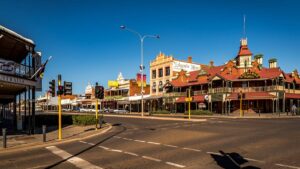Monsters of Rock: And today on BHP watch …

BHP and Anglo's plans are starting to look eerily similar. Pic: Getty Images
- Anglo American’s decision to demerge some of the same businesses BHP has already proposed to cull could play into the big miner’s hands in $65bn takeover tussle
- South32 says push for green metals is already starting in Europe in shift to bifurcated aluminium market
- Madeleine King cranks up PR machine on Labor critical minerals and hydrogen strategy amid ‘billions for billionaires’ criticism
Anglo American’s refusal of BHP (ASX:BHP) and its takeover bid took yet another turn last night as the London listed target offered to emaciate itself in a bid to ward off its hunter.
BHP dearly wants its copper assets. Anglo’s coal mines are also a handy addition for the world’s biggest miner, effectively connecting the five operations it already runs in Queensland’s Bowen Basin.
Including the Grosvenor mine, those will be the most attractive assets sold as part of a slimming plan from Anglo, which will keep its copper and iron ore and jettison basically everything else, selling its diamond and nickel businesses and shunting its platinum operations into a demerged entity. A potash development in the UK part owned by Gina Rinehart will also be ‘slowed down’ with Anglo to assess its capital needs next year.
Nothing is committed for 2026.
It’s all eerily similar to BHP’s plan, which includes the demerger of Anglo’s Kumba iron ore and platinum divisions, with the added bonus of inviting the vultures of private equity and pure play coal to pick apart at its meaty bones.
Grosvenor, Moranbah North, Capcoal and Dawson produce between them a similar quantity of steelmaking coal to the Daunia and Blackwater mines sold by BHP to Whitehaven Coal (ASX:WHC) this year for up to US$4.1 ($6.4b).
In response BHP’s shares were up 2.43% this morning, with some market watchers musing that BHP (as well as Whitehaven, Peabody, Stanmore and a host of other coal believers) could well make a play for the coal assets alone.
Finding it super amusing that many assume BHP will not bid for Anglo American’s met coal assets
– Anglo coal assets highly synergistic with existing BMA assets. Will provide BHP an unreplicable position in some of the world’s best met coal assets.
– BMA has already divested…
— Emanuel Ajay Datt (@eadatt) May 14, 2024
At the same time, BHP may be feeling that Anglo’s strategy will play right into its hands, even if an early drop gave way to a 1.4% gain for the London listed miner last night, coming a day after it rejected a $64.5b bid from its suitor.
Wood Mackenzie’s James Whiteside said the plan from Anglo to split itself and demerge the politically sensitive AmPlats business in South Africa could lend credibility to plans BHP has already expounded.
Henry on the offensive
The Anglo-Ozempic plan was well-timed for BHP CEO Mike Henry, who had the perfect soapbox at the Bank of America global metals, mining and steel conference last night.
“Shareholders were calling for it previously, brokers have called for it, it’s included in our proposal, and you see some variants on it today in the alternative plan,” Henry said.
“So we actually believe that this is fully executable. In terms of spinouts we have previously spun our South32, our petroleum business, Anglo themselves have spun Thungela, Mondi and AngloGold.
“So that path towards spinning businesses out is relatively clear and there’s a long track record of being able to do that successfully.”
Henry claimed the first thing he did after its private discussions with the Anglo board were ‘leaked’ was go to South Africa to ensure its decisions to not want Kumba iron ore or AmPlats were not about the jurisdiction.
“I’ve been clear iron ore is not a commodity that we’re looking at for major growth – we’ll look for incremental growth, low-capital investment and so on in the existing business, but it’s not a business that we see as being one of the core growth pillars for us going forward,” Henry said.
“And so when we look at the South African asset in particular, where there’s no synergies in terms of existing BHP businesses, it was clear that you’ve got a ready-made solution here, given that these two companies are listed.
“The pretty clear and better approach from our perspective was to spin these two businesses out and then BHP is offering a very significant premium for the currently unlisted assets.”
Henry said it was ‘ultimately for shareholders to just what they’ve heard’.
Indeed.
Europe goes green as metal producers feel pressure
Also hanging around the conference in Miami, South32 (ASX:S32) boss Graham Kerr has laid out the challenges ahead for smelter operators, saying they will need to go green to sell into non-Chinese jurisdictions.
With the bulk of its emissions generated at the Hillside aluminium smelter in South Africa, where it draws power from Eskom’s coal dominated grid, Kerr says the energy transitioning miner is seeing the effect of green metal demand.
“The other dynamic is if growth comes outside of China, you’re actually seeing a consumer drive at the moment not necessarily driven by regulatory requirements, but some of the key customers are already talked to us about their preference for green metal,” Kerr said.
“So we’re seeing that at Hillside today, where we’ve had to move some of our sales from Europe into basically the US because the Europeans are far more discerning on where they’re actually buying the material from.
“So we do believe that next stage of … smelter developments will probably occur in Indonesia or Malaysia, but for it to be competitive outside of China, it’ll have to find a way to be green.”
The same logic sits behind the latest budget tabled by the Federal Government, which includes $22.7 billion for its “Future Made in Australia” program.
The budget item includes long term commitments to subsidise critical minerals refining and hydrogen production, criticised by Peter Dutton’s Coalition Opposition as ‘billions for billionaires’.
“We’ve got $13.7 billion dollars of handouts to billionaires in production tax credits,” Shadow Treasurer Angus Taylor said on the 7.30 Report last night.
“I mean that’s not a restraint.
“$13.7bn is a massive spend. If you want to get those resources sectors really firing … you’ve got to drive down energy prices.
“You have to make sure you do the approvals in a timely way, not 14 years which is the average.
“We want to see a successful manufacturing sector and particularly minerals processing … we strongly support having those sectors being strong … but the way to get there is to focus on the fundamentals not to throw money at them with subsidies.”
Resources Minister Madeleine King noted today that the policy still needs legislation to pass before it can be put in action, including a $7bn, decade long commitment to establish a production tax credit for refining of critical minerals like lithium, nickel, rare earths and high purity alumina.
“We need to make sure the programming and the processing, the development of this tax initiative is done right. And we’re going to do that,” she said on ABC Radio in Perth this morning.
“I know that might be difficult for nickel right now, but there are a lot of companies mining right now that aren’t processing yet, and this will drive investment into the processing side of things, and that’s what we want to happen.
“You can’t flick a switch on this stuff overnight as much as we might want to.
“We are sending a signal right now to investment and investors from right around the world to make sure they know Australia and in particular Western Australia is the perfect place to invest if they want to invest in critical minerals and rare earths and a green energy future.”
A late break-up
While BHP is trying to woo Anglo, another potential partnership has broken up before it even really got started.
Ken Brinden’s Patriot Battery Metals (ASX:PMT), owner of the large Corvette spodumene deposit in Quebec’s James Bay region, says it’s free to seek downstream processing partnerships elsewhere after a nine month MoU period with Albemarle wrapped up.
Charlotte-based Albemarle, the world’s biggest lithium producer, took a near 5% stake in PMT via a C$109m investment last year, shortly after the release of Corvette’s initial 109Mt at 1.42% Li2O resource estimate.
Brinsden and his board are framing the conclusion of the exclusivity period in positive terms, saying ‘enabling the company to fully engage with other downstream companies has been determined to be in the best interests of shareholders.’
The market ain’t. It’s shares have tumbled more than 8% since the news popped up.
That’s rough buddy. The materials sector ran 1.41% higher at 3.30am AEST as BHP’s lift pulled the market up by its bootstraps.
It was helped by higher copper prices, with Comex Futures in New York reported as much as U$1000/t above LME benchmark prices, lifting above US$5/lb today for the first time.
Today’s Best Miners
WA1 Resources (ASX:WA1) (niobium) +6.3%
Metals Acquisition (ASX:MAC) (copper) +5.7%
Spartan Resources (ASX:SPR) (gold) +4.7%
Arcadium Lithium (ASX:LTM) (lithium) +3.7%
Zimplats Holdings (ASX:ZIM) (platinum/palladium) +2.8%
Today’s Worst Miners
Patriot Battery Metals (ASX:PMT) (lithium) -6.3%
Core Lithium (ASX:CXO) (lithium) -5%
Westgold Resources (ASX:WGX) (gold) -3.5%
Resolute Mining (ASX:RSG) (gold) -2.7%
Monstars share prices today
ASX 300 Metals and Minings Index today

UNLOCK INSIGHTS
Discover the untold stories of emerging ASX stocks.
Daily news and expert analysis, it's free to subscribe.
By proceeding, you confirm you understand that we handle personal information in accordance with our Privacy Policy.








